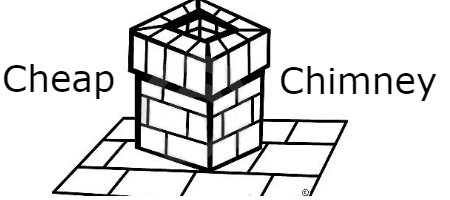Improve Fireplace Energy Efficiency
Posted by Jim Hessenauer on
Don't Lose Heat Up the Chimney

You've probably heard the paradox more than once. A traditional masonry fireplace drains more heat from your home than it produces. The design and efficiency of fireplaces has improved over the years, but the fact still remains. A fireplace is often not a cost-efficient way to heat your home.
In fact, only 10 to 20 percent of the heat produced in a traditional fireplace goes toward heating your home. The rest goes straight up the chimney. That means that for every $100 worth of firewood you purchase, $80 to $90 of the heat produced is lost to the outside world. Most homeowners understand this and accept the trade off. A fire in the living room is not cost-effective from a heating standpoint, but it is romantic.
The problem is simple. A chimney with an open damper draws much more air than is needed for actual combustion. As the draft is created, a large volume of air rushes up the chimney and out along with the fumes and smoke. Where does that air come from? Exactly. It comes from inside your home. So the inside air that you've heated by other means can actually be sucked out the chimney and replaced by colder air that comes in from outside.
This problem can occur even when your fireplace is not in use. If you leave the damper open, a natural draft will occur, sucking out the warm air and replacing it with cold. After the first month's heating bill, you're not likely to make that mistake again! But even if the damper is closed, it may not seal properly. While this won't drain as much heat as an open damper, it can still affect the bottom line. It's worth it to have your damper inspected for a tight seal and replaced if necessary.
One possibility to consider is a fireplace that uses outside air for combustion. You can have vents installed so that the fire actually draws air from a vent behind that connects it to the outside world. To make this work, you need to make sure your glass doors are airtight. You want the draft created with the outside air entirely, and you don't want to be losing heated air out the vent when the fireplace isn't in use.
Of course, the same glass doors that inhibit that air flow can also considerably reduce the amount of heat that gets from the fire into your home. Tubular grates can increase the useable heat from a fire. These are hollow metal frames fitted into the fireplace. Sometimes they are C-shaped. The grates on their own won't increase heating efficiency much-perhaps $1 to $2 for every $100 in firewood. But if the grate is equipped with a blower or fan, that efficiency can be doubled.
You might also consider a "heatilator" type fireplace. The "heatilator" circulates room air around the firebox and blows it out again. It sucks in air through the bottom, sends it around the firebox to warm it and blows it (or simply lets it escape) out the top. These devices can be rather expensive, but they can improve heating efficiency by up to 30%.
Lastly, you might consider a wood or coal stove. While this won't give you as much viewing area for the fire, it does have it's own romance. And there's no question that a wood or coal stove is more efficient than a masonry fireplace at creating lasting heat for the home. A wood or coal stove greatly limits the amount of air being pulled from the room and exhausted up the flue, but many also have multiple combustion chambers and circulation chambers. These allow the stove to extract the most heat from the fuel you're burning.
